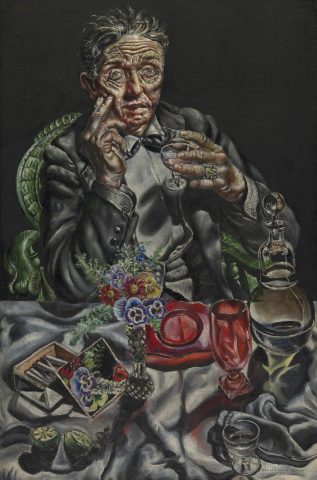Paris: a pivotal exhibition reintroduces 1930’s American masters
- Ivan Albright, Self-Portrait, 1935. Chicago, The Art Institute of Chicago, Mary and Earle Ludgin Collection © The Art Institute of Chicago.
- Grant Wood, American Gothic, 1930; Chicago, The Art Institute of Chicago, Friends of American Art Collection © The Art Institute of Chicago.
- Nan Wood Graham and Dr. Byron McKeeby, models for Grant Wood’s American Gothic, pose next to the painting at an exhibition in Cedar Rapids, Iowa on September 4, 1942.
- Doris Lee, Thanksgiving, circa 1935. Chicago, The Art Institute of Chicago, Mr. and Mrs. Frank G. Logan Purchase Prize Fund © The Art Institute of Chicago.
- Morris Kantor, Haunted House, 1930. Chicago, The Art Institute of Chicago, Mr. and Mrs. Frank G. Logan Purchase Prize Fund © The Art Institute of Chicago.
There is a great season of figurative painting that main art fairs are currently neglecting and very few art dealers, and collectors, seem to be interested in. It is the period of time that goes from the end of the Great War until the beginning of the Second World War, the global turning point that generated the cultural leadership of the United States and, perhaps, gave a first serious chance to China to bridge the gap between itself and the other emerged countries. It was a period of social tension, inequality and economic crisis almost everywhere in Europe and in the United States, where artists such as Edward Hopper, Georgia O’Keefe and Charles Sheeler were representing with realist sensitivity the American way to progress and its sometimes tragic consequences.
Some of their masterpieces are currently on exhibition at the Musée de l’Orangerie, in Paris, in the company of works by some “regional” Mid West artists such as Joe Jones, Marvin Cone, Thomas Hart Benton, Alexandre Hogue, Morris Kantor, Helen Lundeberg and Grant Wood, whose celebrated painting ‘American Gothic’ is shown for the first time ever in Europe, just a few steps away from Leonardo’s Monna Lisa, that was clearly a main source of inspiration for this pivotal painting.
While their European colleagues from the so called Neue Sachlichkeit and from the Italian Novecento movement were experiencing the socialist regimes and their aggressive propaganda, in the US the Great Depression made millions of Americans losing their dignity, along with their jobs, properties and savings, as John Steinbeck’s novel Mice and Man described in 1937, when it was published – perhaps it’s worth remembering that that same year the unarmed rural town of Guernica was bombed by Nazi and Fascist’s new Agusta warplanes.
Nevertheless, despite Europe and US were still very distant societies and economies at that time, the first impression we had visiting American Painting in the 1930s, the age of anxiety has been that figurative art production in these two continents were surprisingly consistent. From the many references to old masters and Flemish painting, to the constant distortion of the perspective’s rules, even the so called “regional” painters seem they were elegantly swimming in the same pond, a dark pond that was filled with bright oil painting of extraordinary vivid colours.
The exhibition’s most important work and a milestone in the American art history, Grant Wood‘s “American Gothic”, was painted in 1930 for the art prize of the Art Institute Chicago. It won the artist 300 dollars and the institution bought the painting – at this point you may like to know that Wood’s highest price at action was paid for Spring Plowing in 2005, when an American collector purchased it for almost $ 7 million. Even if he called himself a self-thought farmer painter, Woods was actually classically trained and travelled in Europe between 1920 and 1926 visiting Paris and Munich. Wood’s sister, Nan, and his dentist, Dr. Byron Mckeeby, were his models for American Gothic, that was painted after the artist had visited the small town of Eldon, in his native Iowa. “I imagined American Gothic people with their faces stretched out long to go with this American Gothic house” he said, addressing the style of the building in the background. According to his biographer, Evans, R. Tripp. (Grant Wood [A Life], 2010) he was gay, and lived most of his adult life with his mother. He died of cancer in 1942. That same year the Allies fighting Hitler and Mussolini started to call themselves the United Nations.
October 28, 2016





